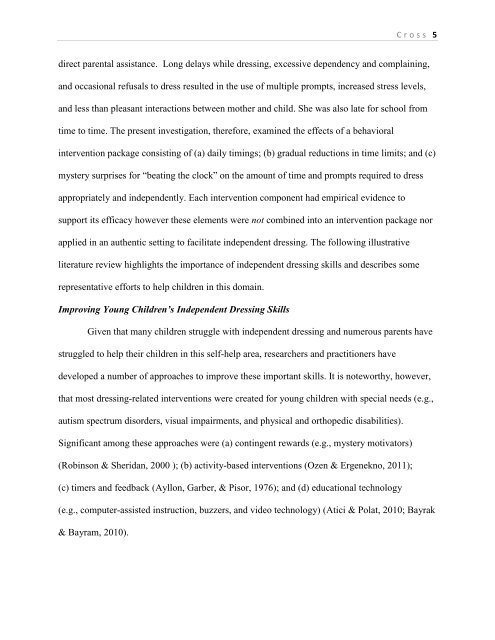THE EFFECTS OF A TIMER AND MYSTERY MOTIVATORS ON THE ...
THE EFFECTS OF A TIMER AND MYSTERY MOTIVATORS ON THE ...
THE EFFECTS OF A TIMER AND MYSTERY MOTIVATORS ON THE ...
You also want an ePaper? Increase the reach of your titles
YUMPU automatically turns print PDFs into web optimized ePapers that Google loves.
C r o s s 5<br />
direct parental assistance. Long delays while dressing, excessive dependency and complaining,<br />
and occasional refusals to dress resulted in the use of multiple prompts, increased stress levels,<br />
and less than pleasant interactions between mother and child. She was also late for school from<br />
time to time. The present investigation, therefore, examined the effects of a behavioral<br />
intervention package consisting of (a) daily timings; (b) gradual reductions in time limits; and (c)<br />
mystery surprises for “beating the clock” on the amount of time and prompts required to dress<br />
appropriately and independently. Each intervention component had empirical evidence to<br />
support its efficacy however these elements were not combined into an intervention package nor<br />
applied in an authentic setting to facilitate independent dressing. The following illustrative<br />
literature review highlights the importance of independent dressing skills and describes some<br />
representative efforts to help children in this domain.<br />
Improving Young Children’s Independent Dressing Skills<br />
Given that many children struggle with independent dressing and numerous parents have<br />
struggled to help their children in this self-help area, researchers and practitioners have<br />
developed a number of approaches to improve these important skills. It is noteworthy, however,<br />
that most dressing-related interventions were created for young children with special needs (e.g.,<br />
autism spectrum disorders, visual impairments, and physical and orthopedic disabilities).<br />
Significant among these approaches were (a) contingent rewards (e.g., mystery motivators)<br />
(Robinson & Sheridan, 2000 ); (b) activity-based interventions (Ozen & Ergenekno, 2011);<br />
(c) timers and feedback (Ayllon, Garber, & Pisor, 1976); and (d) educational technology<br />
(e.g., computer-assisted instruction, buzzers, and video technology) (Atici & Polat, 2010; Bayrak<br />
& Bayram, 2010).
















